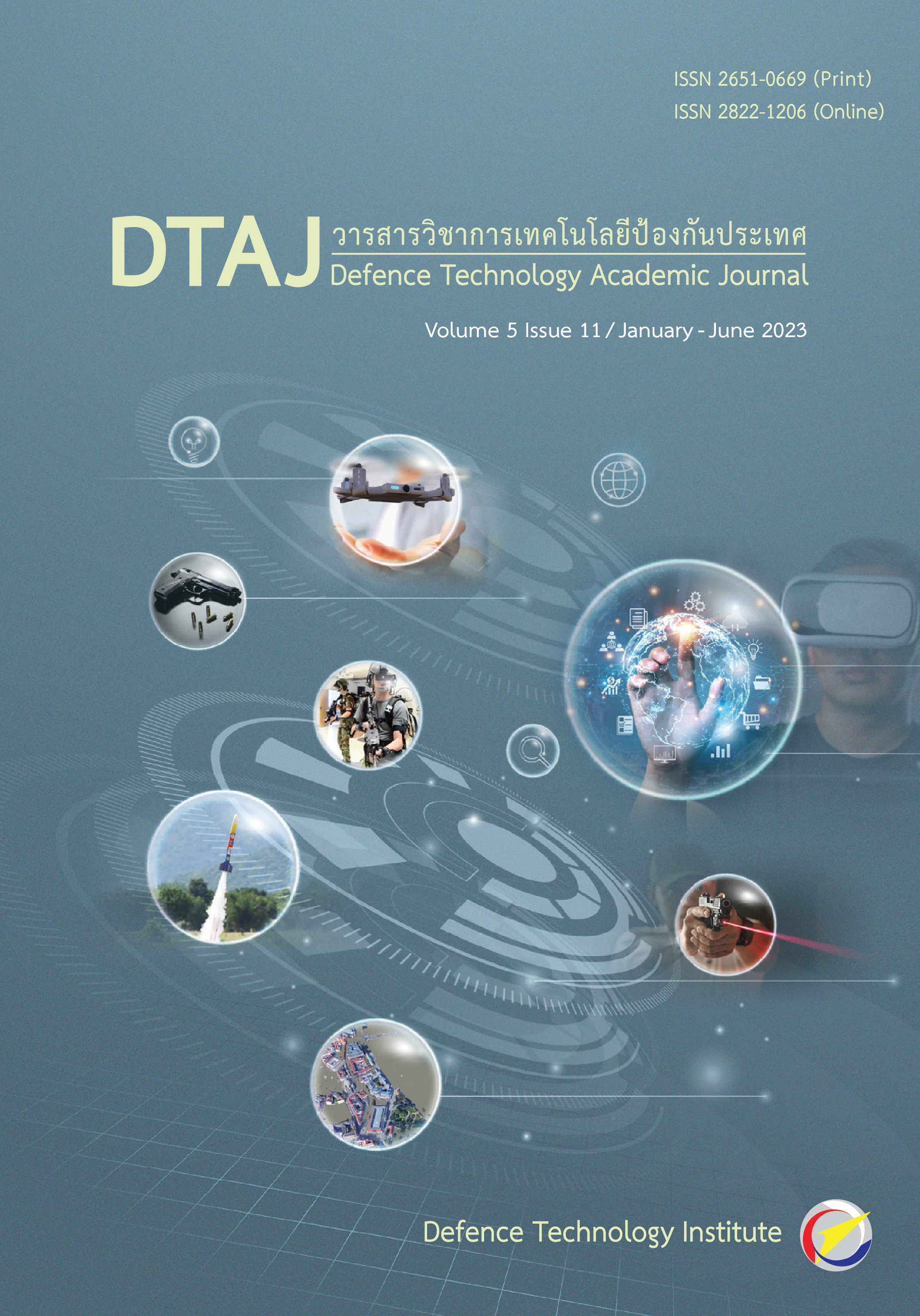A Development of Numerical Solution for Non-Linear Inventor Rocket Equation of Motion
Main Article Content
Abstract
When an inventor rocket moves away from the launch point, the inventor rocket passes through the medium, which is air, to the target area along the designed line of motion. But because there are factors. As a result, the movement of the inventor rocket trajectory deviates from the normal direction it was designed for and the nature of the equation is nonlinear. Therefore, it is essential to study, design and solve this nonlinear motion problem in order to reduce possible faults and further increase the efficiency of emission accuracy. Solving the nonlinear motion equations can be done in a variety of ways, with this paper presenting the method of finding the deuteronomy of the equations with the methods of Runge-Kutta 4th, using the inventor rocket trajectory equation based on the Modified Point Mass Trajectory Model, which experimented with transforming the initial state into 21 patterns. The simulation results showed inventor rocket trajectories with different lift angles and initial conditions. Whereas with a greater lift angle and starting conditions, the distance perpendicular to the flight plane is significantly higher. In addition to that, it will result in the position of the inventor rocket at any given time. There are markedly different values as flight time increases.
Downloads
Article Details

This work is licensed under a Creative Commons Attribution-NonCommercial-NoDerivatives 4.0 International License.
Journal of TCI is licensed under a Creative Commons Attribution-NonCommercial-NoDerivatives 4.0 International (CC BY-NC-ND 4.0) licence, unless otherwise stated. Please read our Policies page for more information...
References
R. L. McCoy, Modern Exterior Ballistics: The Launch and Flight Dynamics of Symmetric Projectiles. Atglen, PA, USA: Schiffer Publishing, 1999.
A. Ko, K. Chang, D. Sheen, C. Lee, Y. Park, and S. Park, “Projectile Prediction and Aanalysis of the Aerodynamic Characteristics of a Spinning Projectile Based on Computational Fluid Dynamics,” Def. Sci. J., vol. 188, pp. 132-147, 2020.
S. Gupta, S. Saxena, A. Singhal, and A. K. Ghosh, “Trajectory Correction Flight Control System Using Pulsejet on an Artillery Rocket,” Def. Sci. J., vol. 58, no. 1, pp. 15-33, Jan. 2008.
G. Arora, V. Joshi, and I. S. Garki, “Developments in Runge-Kutta Method to Solve Ordinary Differential Equations,” in Recent Advances in Mathematics for Engineering, 1st ed. Boca Raton, FL, USA: CRC Press, 2020, ch. 9, pp. 193 - 202, doi: 10.1201/9780429200304-9.
L. An, L. Wang, N. Liu, J. Fu, and Y. Zhong, “A Novel Method for Estimating Pitch and Yaw of Rotating Projectiles Based on Dynamic Constraints,” Sensors, vol. 19, no. 23, p. 5096, 2019.
C. J. Voesenek, “Implementing a Fourth Order Runge-Kutta Method for Orbit Simulation,” 2008, pp. 1 - 3. [Online]. Available: http://spiff.rit.edu/ richmond/nbody/OrbitRungeKutta4.pdf
P. G. Thomsen, “A Generalized Runge-Kutta Method of Order Three,” 2002. [Online]. Available: http://www2.imm.dtu.dk/pubdb/ pubs/858-full.html
F. Rabiei, “Fifth-order Improved Runge-Kutta Method with Reduced Number of Function Evaluations,” Aust. J. Basic Appl. Sci., vol. 6, no. 3, pp. 97 - 105, Jan. 2012.
H. Séka and K. R. Assui, “Order of the Runge-Kutta Method and Evolution of the Stability Region,” Ural Math. J., vol. 5, no. 2, p. 64, Dec. 2019, doi: 10.15826/umj.2019.2.006.
S. Hippolyte and A. K. Richard, “A New Eighth Order Runge-Kutta Family Method,” J. Math. Res., vol. 11, no. 2, pp. 190 - 199, Mar. 2019, doi: 10.5539/jmr.v11n2p190.
T. Feagin, “A Tenth-order Runge-Kutta Method with Error Estimate,” in IAENG Int. Conf. Sci. Comput., Hong Kong, 2007.
R. F. Lieske and M. L. Reiter, “Equations of Motion for a Modified Point Mass Trajectory,” Ballistic Research Laboratories, Aberdeen Proving Ground, MD, USA, Rep. 1314, 1966.
L. Baranowski, “Feasibility Analysis of the Modified Point Mass Trajectory Model for the Need of Ground Artillery Fire Control Systems,” J. Theor. Appl. Mech., vol. 51, no. 3, pp. 511 - 522, Jan. 2013.
L. Baranowski, “Equations of Motion of a Spin-stabilized Projectile for Flight Stability Testing,” J. Theor. Appl. Mech., vol. 51, no. 1, pp. 235 - 246, Jan. 2013.
L. Baranowski, “Effect of the Mathematical Model and Integration Step on the Accuracy of the Results of Computation of Artillery Projectile Flight Parameters,” Bull. Pol. Acad. Sci.: Tech. Sci., vol. 61, no. 2, pp. 475 - 484, Jun. 2013, doi: 10.2478/bpasts-2013-0047.


